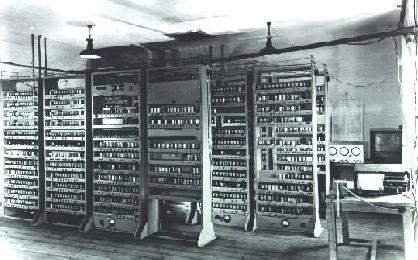|
|
|||||
| Computer Laboratory The History of the Computer Lab |
||
| Computer Laboratory > The History of the Computer Lab |

The Computer Laboratory, then known as the Mathematical Laboratory, was founded in 1937. The first Director was Professor J.E. Lennard-Jones (Professor of Theoretical Chemistry), and the only staff member was M.V. Wilkes, appointed as a University Demonstrator. The Laboratory was intended to house mechanical computers to provide a service to the rest of the University. It was taken over by the Ministry of Supply during WW II, and returned to civilian use in 1945 with M.V. Wilkes as Acting Director (Director from 1946). Work began on the EDSAC (Electronic Delay Storage Automatic Calculator, later referred to as EDSAC I), following Wilkes' visit to the Moore School of Engineering at the University of Pennsylvania in July/August 1946. The first logged program on EDSAC I (computing the squares of integers from 1 to 99) ran on 6th May 1949. This was the first complete and fully operational regular electronic digital stored program computer. Program service to University members began on a semi-formal basis in 1950. From 1953 onwards heavy use was made of EDSAC 1 to solve problems in meteorology, genetics, X-ray crystallography & radioastronomy, among other subjects. The Preparation of Programs for an Electronic Digital Computer by Wilkes, Wheeler, and Gill, (Addison-Wesley, 1951) was the first book on programming to be published. EDSAC I was shut down on 11th July 1958. Its successor, EDSAC II (1958-1965), was the first full-scale microprogrammed machine, also the first bit-sliced machine with interchangeable plug-in units. EDSAC II was followed by the TITAN (1964-1973), which was essentially a cut-down version of the Ferranti Atlas computer. It was built of transistors, rather than the valves used in EDSAC I & II. It featured the first operating system (Temporary Supervisor by Swinnerton-Dyer), and an early multiple-access system allowing remote access from desktop terminals. It was used among many other things for early work on graphics interfaces and computer-aided design. The original Mathematical Laboratory building was demolished in 1969 and the Laboratory moved to a new building on an adjoining site, and gradually expanded into several other buildings on the New Museums Site. The Mathematical Laboratory was renamed the Computer Laboratory in 1970, and became an institution independent of any faculty, responsible to the Computer Syndicate. The Computing Service divided from Teaching & Research within the Laboratory, with D.F.Hartley becoming the first Director of the University Computing Service. Since 1970 research within the lab has covered such areas as memory protection hardware (the CAP project); distributed systems (the Cambridge Model Distributed System); fast networks (the Ring project, and the Cambridge Fast Ring); formal verification of hardware designs; interconnection of LANs by satellite (Project UNIVERSE); specialised graphic displays (the Rainbow display, and later the Autostereo display); natural language processing; multimedia computing; authentication and security; theorem proving (eg Isabelle). On the teaching side: the first research student in the Laboratory, J.M. Bennett, started in 1947. The Diploma in Numerical Analysis and Automatic Computing began in 1953, a one-year postgraduate course, and the first formal course in Computer Science leading to a university qualification anywhere in the world. A one-year Computer Sciences Tripos for undergraduates started in 1971, expanding to two years in 1978 and the current three years in 1989. Building on its long and distinguished history, Teaching & Research continue within the Computer Laboratory at a world-class level: it received a 5* rating (the top rating) in the 1996 UK research assessment exercise and was rated as excellent in the most recent (1994) UK teaching quality assessment. In Summer 2001 the Computer Laboratory moved out to the West Cambridge Site to a purpose built new building.
EDSAC99The Computer Laboratory celebrated the 50th Anniversary of the EDSAC 1 computer in April 1999 with a two day meeting, including talks about EDSAC 1 and subsequent work in the Laboratory, historic exhibits and demonstrations of current research, together with a reception and dinner.
The Relics ProjectThis project aims to catalogue and preserve the various artifacts of historical interest stored within the lab, and to create video recordings of lab members who used our early computers talking about those artifacts. The project started in September 1997, and the first video recorder was Prof. David Wheeler.Search the object database: Over 150 items from the earliest days of the Mathematical lab to the present day.
ResourcesEDSAC
|